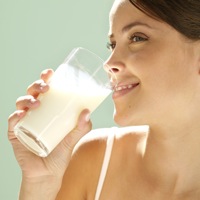 Sure, milk does a body good, but how much is enough? Also, what type should your child be drinking? And when is water a better option? Read on to find out – the answers might surprise you.
Sure, milk does a body good, but how much is enough? Also, what type should your child be drinking? And when is water a better option? Read on to find out – the answers might surprise you.New guidelines for toddlers
It used to be that when a child turned 2, pediatricians would tell parents to switch them from whole milk to 2 percent milk – but that’s no longer the case. In fact, the American Academy of Pediatrics issued new recommendations in 2008 stating that after age 1, kids should drink skim or 1 percent milk.
So why the lag? “It’s going to take a while for that to shift, because the thinking had always been: Don’t put kids on a low fat or non-fat diet—they need fat,” said Dr. Laura Jana, a pediatrician, spokesperson for the American Academy of Pediatrics (AAP) and co-author of Food Fights: Winning the Nutritional Challenges of Parenthood Armed with Insight, Humor, and a Bottle of Ketchup.
“Not all fat is created equal,” said Jana, who notes it’s more important to look at the amount of saturated fat versus the amount of total fat when it comes to milk. Monounsaturated fats like those found in olive oil, avocado, nuts and seeds are the good fats that should be a part of a child’s diet.
In addition, the AAP recommends reduced-fat milk for children 1 to 2 years old who are at risk for being overweight or obese.
They’re probably drinking enough
Breast milk or formula is a big part of a baby’s diet, but after the age of 1, there’s no reason to be alarmed if the amount drops. “They just finished the fastest growth rate they’re going to have in that first year,” Jana said. She added that eating table food usually provides enough calories and nutrients for your baby to develop.
Between ages 1 and 2, toddlers are also more active. “They don’t eat as much and sometimes they don’t need as much,” Jana said.
Iron and vitamin D is another issue when offering milk. Drinking milk is great for vitamin D, but drinking too much can decrease iron levels and may even lead to anemia. For children ages 2 to 5 years old, two cups a day and no more than 16 ounces is enough to maintain vitamin D and iron, according to a recent report in the journal Pediatrics.
After age 1, aim for two to three cups, or no more than 24 ounces a day. If your child’s eating yogurt and cheese, less is OK. For ages 2 to 8, aim for two cups and for ages 9 and older, three cups.
When it’s too much
 Drinking milk all day long isn’t a good idea, especially because it can ruin a child’s appetite for meals. Also, bathing teeth consistently in milk’s natural sugars can lead to tooth decay.
Drinking milk all day long isn’t a good idea, especially because it can ruin a child’s appetite for meals. Also, bathing teeth consistently in milk’s natural sugars can lead to tooth decay.A good rule of thumb is milk with meals and water with snacks, Jana suggests.
During the warmer months or when your kids are playing outside, water is a better option than juice, milk or sugary drinks to keep them hydrated. “It keeps kids more focused on the drink for thirst,” Jana said. “If you get them in the habit of it, they like water.”
0 comments:
Post a Comment